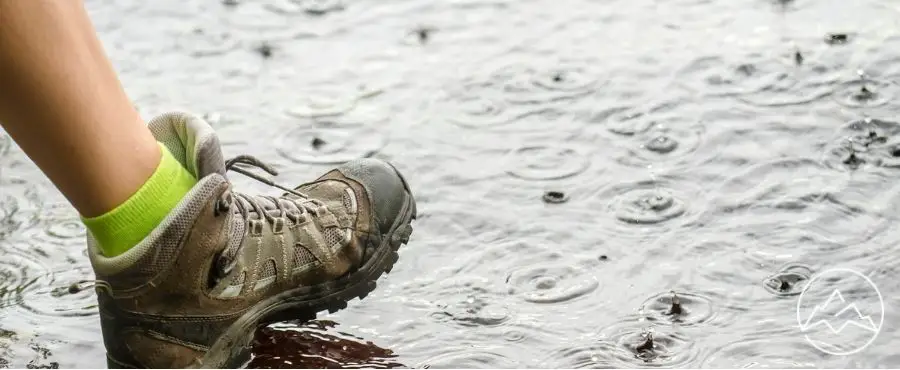When you’re hunting, hiking, or exploring the wilderness, it’s critical to keep your feet dry. Not only will it help prevent blisters and chafing on your trek, but it will also help you stay healthy and prevent you from catching a cold or even developing frostbite.
Although most boots that are made for the outdoors use Gore-Tex to protect them from leaks and other waterproof technology, they can wear out over time and might leave your feet exposed to the elements.
Here, we’ll give you tips on how to waterproof boots and instructions on three different ways you can do it. These are all simple, inexpensive, and something you can do at home before your next hunting trip to keep your feet warm and dry in even the harshest conditions.
Reasons your boots start to leak
Even if you invest in a high-quality pair of boots that start out waterproof, they may start to leak over time if you don’t help maintain the seal. There are a few different reasons this can happen, but if you know how to waterproof boots, then you can extend their life.
Common reasons the seal starts to fail include:
- Exposure to heat, like a campfire or fireplace
- Walking long distances erodes the seal
- Flexing and battering caused by uneven terrain
By regularly waterproofing leather boots, you can ensure that you never start to experience leaks, even if they have a lot of wear and tear from use.
Check out our picks for the best hunting boots!
Techniques to waterproof your boots
Learning how to waterproof leather boots is easy. There are many different products that work well, and you can find them at local hardware and hunting stores. Here are a few proven techniques to try.
The unconventional toilet wax ring
For less than five dollars, you can pick up a toilet wax sealing ring at your local hardware store. In the bathroom, these are used to make sure that nothing leaks out of your toilet when you flush. The wax is impenetrable. Because of that, it makes it a perfect waterproofing material for your boots.
To do it, first, wipe any dirt or debris off your boots so that you’re applying the wax to a clean surface. Gently warm the wax by setting it on a heating vent, near a fire, or in the sunshine. They don’t have to be hot, just warm enough that the wax softens.
Then, use a cloth or your hands to gently rub the wax on all of the leather surfaces of your boots. Let it dry completely before wearing.
Beeswax
Another inexpensive option is to use a commercial beeswax product that’s designed for waterproofing fabric and leather. Kiwi Camp Dry Beeswax is one name brand you might recognize. It’s easy to find at locations like drugstores or online, and it is effective at repelling water on many different types of materials.
To use it, let the wax warm in the sun or near a heat source until it softens, and then apply it to your clean, dry boots. Take care to only put it on the leather or fabric and not the rubber soles because it will make them slick. You may also want to wear gloves to avoid waterproofing your fingers and hands during the process.
Let the wax dry completely overnight and then give your boots a good wipe with a cloth to remove any excess that didn’t absorb. You can repeat this process as needed depending on how often you wear your boots. If you’re someone who spends a lot of time outdoors, it’s smart to do this monthly to keep the waterproof seal intact.
If the material starts to look dry or scuffed, you know you’re due for another treatment. If you don’t wear your boots often or aren’t usually in extreme conditions, beeswax could last for years before you need to repeat the process.
Waterproofing spray
If you’re someone who wants to know how to waterproof boots the quick and easy way, then you might prefer using a waterproofing spray. These are also easy to find in stores and online, and the application process only takes a few minutes.
There are two main types of sprays, grease-based and silicone. Grease-based options are best if you regularly are in muddy or swampy areas. They’re not the right choice if your boots are made of suede or nubuck because they don’t work well with those materials.
Silicone sprays are more frequently used on slick surfaces, like hiking gear and tents, and are effective at repelling water and moisture on boots. They’ll create a shiny finish, but take care not to use too much because it can dry out your leather and cause it to crack.
Regardless of which spray type you choose, you’ll want to start by cleaning off your boots with a brush and then getting the exterior wet by holding them under running water. Pat them dry, but make sure the surface still stays slightly damp. This will give you the best absorption when you use the spray.
Set the boots on a flat surface and hold the waterproofing spray about six inches away. Then push the button and coat the surface. You’ll want to do this in short bursts and make sure that you cover every part of the boot. Pay close attention to seams and joints, those are places where it’s most likely water will penetrate, and they need a secure seal to repel it.
Then, let your boots dry overnight until the surface is no longer damp, and the sealant has been fully absorbed.
Preserve the life of your boots by waterproofing
Regardless of which technique you use, waterproofing your boots can extend their life by months if you do it regularly. It’s essential that your feet stay dry when you’re outdoors, and regular maintenance of the material is an easy way to make sure that happens.
All of these techniques are easy to do and won’t break the bank. Try to incorporate them into your routine once every few months to keep your waterproof seal fresh.



